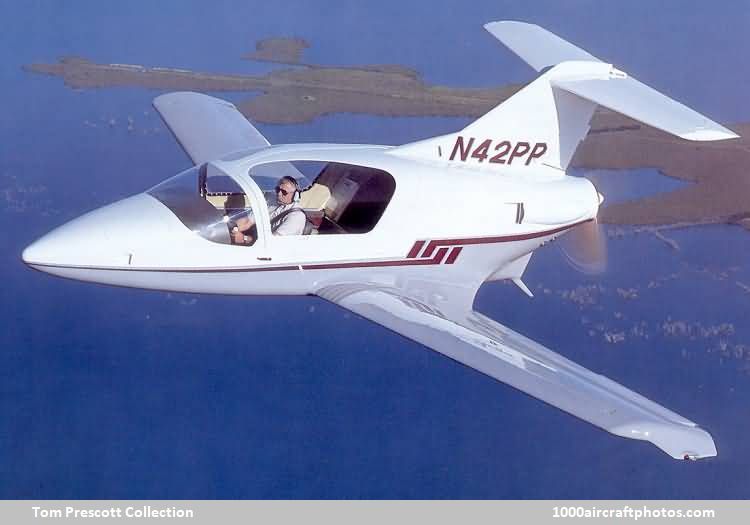09/30/2007. Remarks by Tom Prescott: "Ole Sindberg has more time on his aircraft, N40LE, than any other Pusher kit builder. His hours are approaching that flown by the factory prototypes (shown above and here). Ole installed a Lycoming O-540 engine in his Pusher. I looked at this engine as early as November 19, 1985 and decided the Pusher would become a two-seat airplane and propeller clearance (without a four-bladed propeller) would be an issue (maximum propeller diameter flown was 68 in (1.63 m) and recommended was 65 in (1.65 m) by the factory).
In 2002 Ole was enthusiastic enough to provide me with three pages of recommended improvements for the Pusher based on his experience. It should be noted that Ole uses quote: “2,600 lb (1,179 kg) for my normal maximum gross weight; an alternate gross weight of 2,800 lb (1,270 kg) can be used if four people must be carried, but this weight required a maximum zero fuel weight of 2,600 lb, a maximum landing weight of 2,700 lb (1,225 kg), it further requires a reduction of the maximum speeds and different maneuvering speeds, as well as a reduction in G-tolerance.”
The original design maximum take off gross weight (TOGW) was 2,250 lb (1,021 kg). The loads report was modified and structural testing conducted using a maximum TOGW of 2,400 lb (1,089), 3.8G positive and 1.5G negative load factors. It is recommended the Prescott Pusher not be flown outside of this gross weight limit.
The Prescott Pusher was the most publicized and most scrutinized new aircraft introduction in history. There were nine magazine articles written with most authors having flown one or more of the prototypes. None of the Pusher's characteristics or operating envelope was hidden from their careful examination. The performance, verified on a sea level standard day with “blue printed” engine (200+ hp), the Pusher (N42PP) achieved 200 mph (329 kmh) CAS. Analytical and wind tunnel extrapolated stall speeds were verified using a wind tunnel calibrated pitot-static boom. All technical data provided was tested at the 2,400 lb (1,089) TOGW.
The lack of commercial success, in my opinion, boiled down to a change in marketing strategy. The original marketing grass-roots pay-as-you-go approach was elevated to a high-dollar pay-up-front strategy. The most important ingredients to commercial success were thought to be my technical input and knowledge of the aircraft and Stan Blankenship's market savvy. These two key elements evaporated in the face of requirements demanded by the financial backer. The kit aircraft delivered by the factory had the essence but not all the aerodynamic and structural refinements envisioned or planned for the Pusher.
To my surprise, approaching 25 years later, the Prescott Pusher still excites the imagination at every airport where it lands."
Engine: one 180 hp Lycoming O-360
Propeller: four-bladed variable pitch
Span: 29 ft 4 in (8.94 m)
Length: 20 ft 3.4 in (6.18 m)
Height: 8 ft 9 in (2.67 m)
Cabin width: 3 ft 6 in (1.07 m)
Wing area: 110.8 sq.ft (10.29 sq.m)
Aspect ratio: 7.76
Gross weight: 2,400 lb (1,089 kg)
Empty weight: 1,550 lb (703 kg)
Useful load: 850 lb (386 kg)
Baggage: 100 lb (45 kg)
Fuel: 56.5 gal (214 l)
Max cruise speed: 200 mph (322 km/h)
Cruise speed: 190 mph (306 km/h) at 7,500 ft (2,286 m)
Stall speed: Clean 72 mph (116 km/h)
Stall speed: Full flaps 66 mph (106 km/h)
Ceiling: 18,000 ft (5,486 m)
Range: 1,000 mls (1,609 km)
